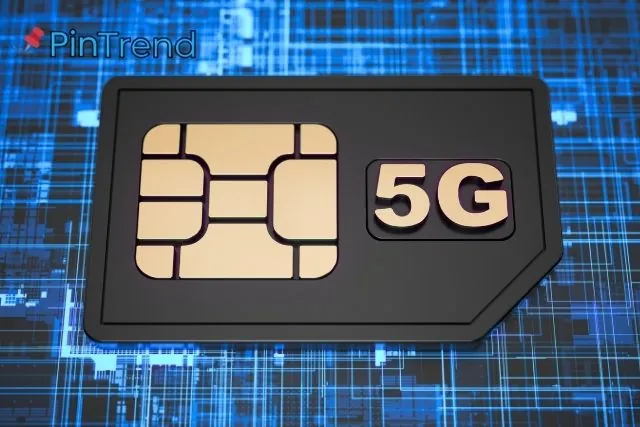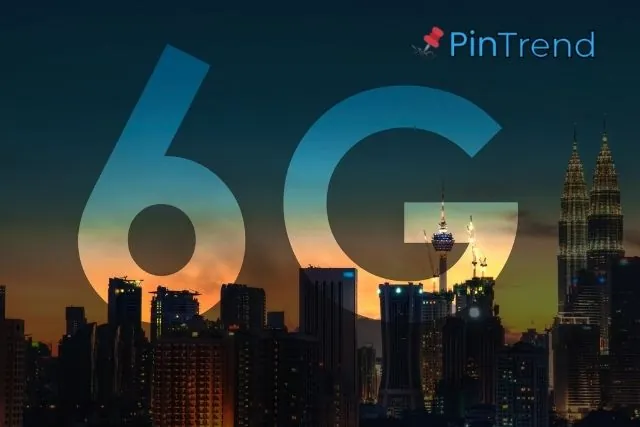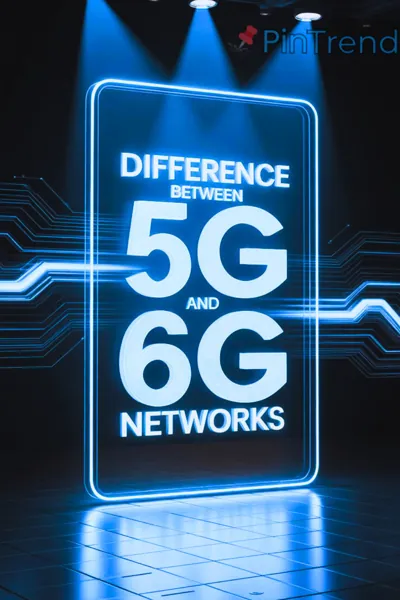Introduction
Wireless networks have evolved tremendously, from 1G’s voice-only calls to 4G’s fast mobile internet and video streaming. Today, 5G technology is transforming connectivity with higher speeds, lower latency, and the ability to connect billions of devices worldwide. But the journey doesn’t stop there. Beyond 5G technology, 6G networks promise to redefine what’s possible in communication with AI-powered communication networks, ultra-low latency communication, and integration of the terahertz spectrum in 6G. This article explores the difference between 5G and 6G networks in points, offering real-world examples, practical insights, and predictions for the future of IoT with 6G, shaping the future of mobile networks globally.
What is 5G Technology?
5G is the fifth generation of wireless networks and has become the backbone of modern connectivity. Launched in the USA around 2019, 5G was designed to overcome the limitations of 4G, offering faster speeds, lower latency, and support for a massive number of devices.
The key features of 5G include data transfer rates of up to 10 Gbps, latency around 1 millisecond, and the ability to connect billions of devices simultaneously. In practice, this supports smart homes, autonomous vehicles, AR/VR applications, and industrial IoT systems. Major US cities like New York, Los Angeles, and Chicago already enjoy wide 5G coverage, while companies like Verizon and AT&T are using it to power real-time applications, predictive analytics, and enhanced streaming services.

What is 6G Technology?
While 5G continues to expand, researchers are already focusing on 6G network research and development. Expected to launch commercially around 6G launch date 2030, this next generation of wireless technology aims to push connectivity beyond speed and reliability.
6G networks will deliver data transfer rates up to 1 Tbps, ultra-low latency communication, and fully AI-powered communication networks capable of self-optimization and predictive decision-making. This will enable immersive holographic experiences, advanced robotics, and fully smart cities and 6G ecosystems. With global coverage, including remote areas and satellite links, 6G promises a future connectivity revolution that could transform healthcare, education, transportation, and even space technology.
Difference Between 5G and 6G Networks
The 5G vs 6G comparison shows significant differences in capabilities and applications.
5G vs 6G Speed and Latency
Speed and latency are among the most noticeable differences. 5G offers data rates up to 10 Gbps and latency around 1 millisecond, enabling seamless streaming and gaming. In contrast, 6G networks are expected to reach speeds up to 1 Tbps with ultra-low latency communication near 0.1 milliseconds.
Example: A remote surgeon performing robotic surgery on 5G experiences minor lag. With 6G, operations could happen in real time without any delay, thanks to AI-powered communication networks.
5G vs 6G Frequency Bands
Another major distinction lies in 5G vs 6G frequency bands. 5G uses sub-6 GHz and mmWave frequencies, offering high speeds but limited coverage in rural areas. 6G will operate in the terahertz spectrum in 6G, unlocking massive bandwidth for high-speed data transfer and supporting applications such as immersive holographic experiences.
5G vs 6G Connectivity and IoT
5G can connect billions of devices, powering smart homes and autonomous vehicles. 6G connectivity expands this to trillions of devices, enabling fully integrated smart cities and 6G ecosystems.
Imagine a city where traffic lights, energy grids, public transport, and emergency services are all interconnected via AI-powered communication networks. This is the future of IoT with 6G, where devices not only communicate but also make intelligent decisions to improve efficiency and safety.
AI-Powered Networks: 5G vs 6G Automation
While 5G supports limited automation and basic network optimization, 6G takes automation to the next level. 6G networks will be AI-powered, capable of predictive maintenance, self-optimizing routing, and real-time adjustments without human intervention. This is one of the most important aspects when comparing 6G vs 5G which is better for industries that rely on continuous uptime.
Coverage and Reliability: 5G vs 6G Comparison
5G coverage is excellent in urban areas but struggles in remote regions. 6G networks aim for global seamless connectivity, combining terrestrial and satellite links to ensure connectivity anywhere on the planet.
| Feature | 5G Networks | 6G Networks |
|---|---|---|
| Data Transfer Rate | Up to 10 Gbps | Up to 1 Tbps |
| Latency | ~1 ms | ~0.1 ms (ultra-low latency communication) |
| Frequency Bands | Sub-6 GHz, mmWave | Terahertz spectrum in 6G |
| AI Integration | Limited | Fully AI-powered communication networks |
| Connectivity | Billions of devices | Trillions of devices (smart cities and 6G) |
| Applications | Smart homes, AR/VR | Immersive holographic experiences, remote surgeries, autonomous transport |
| Coverage | Urban-focused | Global seamless coverage |
This table demonstrates the difference between 5G and 6G in communication, highlighting why 6G is expected to outperform 5G in almost every critical metric.
Advantages of 6G Over 5G Technology
The benefits of 6G go far beyond just speed. 6G networks will support immersive holographic experiences, ultra-fast AI-driven automation, and environmentally sustainable operation with lower energy consumption per data unit.
6G vs 5G technology will also enable:
-
Future-ready IoT: Trillions of devices interacting intelligently.
-
Smart cities and 6G: Autonomous traffic, energy optimization, and public safety systems.
-
Industrial revolution: Remote factories and AI-powered logistics.
By leveraging beyond 5G technology, industries and consumers alike can participate in a future connectivity revolution that redefines work, entertainment, and daily life.
Challenges in Transitioning From 5G to 6G
Despite its promise, the transition to 6G faces hurdles. High infrastructure costs and spectrum allocation challenges could delay rollout. Security and privacy become critical in AI-powered communication networks, and widespread adoption is unlikely before 6G launch date 2030. These challenges highlight that evolution from 5G to 6G is a gradual but necessary process for long-term connectivity improvements.
Future of Mobile Networks: Beyond 5G to 6G
The future of mobile networks promises to revolutionize industries and daily life. In healthcare, ultra-low latency communication allows real-time robotic surgeries. Education will benefit from immersive holographic experiences in virtual classrooms. Transportation, energy, and urban infrastructure will integrate smart cities and 6G, creating intelligent ecosystems.
By 2030, the future connectivity revolution will be powered by AI-powered communication networks, the terahertz spectrum in 6G, and the seamless integration of trillions of devices globally. 6G vs 5G which is better becomes clear when looking at its potential to reshape entire sectors rather than just improving speed.

Conclusion
The difference between 5G and 6G networks is transformative. While 5G powers today’s smart homes, autonomous vehicles, and AR/VR applications, 6G networks promise a leap into a connected, intelligent, and global ecosystem.
Key points summarizing the difference between 5G and 6G in points include:
-
Speed & Latency: 6G offers up to 1 Tbps and near-zero latency.
-
Frequency Bands: 6G uses terahertz spectrum in 6G for extreme bandwidth.
-
Connectivity: Trillions of devices interconnected in smart cities and 6G.
-
AI Integration: Fully AI-powered communication networks for self-optimization.
-
Coverage: Global, seamless connectivity beyond urban areas.
In short, 5G is the present; 6G is the future. By understanding 5G vs 6G technology, industries and consumers can prepare for a world of immersive holographic experiences, intelligent IoT ecosystems, and the future of mobile networks.
People Also Ask:
What are the challenges of 6G network?
High infrastructure costs, spectrum allocation issues, security concerns, and a long timeline for global rollout.
What are the advantages of 6G over 5G?
Faster speeds up to 1 Tbps, ultra-low latency, AI-powered networks, global coverage, and support for trillions of connected devices.
What are the cons of 6G?
Expensive deployment, complex technology, regulatory hurdles, and limited availability before 2030.
Which country has the 6G network?
No country has commercial 6G yet; research is ongoing in the USA, China, South Korea, and Europe.
Who is the leader in 6G?
Countries like China, South Korea, and the USA are leading 6G network research and development, along with companies like Ericsson, Nokia, and Samsung.


